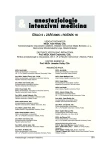Curare: Alternative methods of administration
Authors:
L. Hess 1; V. Rogozov 2; M. Svítek 3; J. Schreiberová 4
Authors‘ workplace:
CEM IKEM, Praha
1; KAR, IKEM Praha
2; KAR VNF Praha
3; Klinika anesteziologie, resuscitace a intenzivní medicíny, FN Hradec Králové
4
Published in:
Anest. intenziv. Med., 16, 2005, č. 5, s. 242-245
Category:
Anaesthesiology - Comprehensive Report
Overview
Nowadays curare-related drugs are usually administered intravenously. South-American Indians used to use curare intramuscularly and indeed the early researchers studied this route of administration. As late as in the 19th and in the first half of the 20th century curare was given intramuscularly for the treatment of tetanus and for muscle relaxation during surgery. Suxamethonium was used in the 1950s for immobilisation of large animals. Several minutes after administration, immobilisation was achieved with the consciousness of the animal preserved. Nowadays the intramuscular administration of neuromuscular blocking drugs is reserved for emergency situations, mostly in paediatrics. More alternative methods (such as intratracheal and intraosseous) are being studied.
Key words:
curare –intramuscular application – animal immobilization – alternative applications
Labels
Anaesthesiology, Resuscitation and Inten Intensive Care MedicineArticle was published in
Anaesthesiology and Intensive Care Medicine

2005 Issue 5
Most read in this issue
- Curare: Alternative methods of administration
- Curare: Some historical facts
- Development in anaesthetic technique in the extremely low weight infant, 1998–2003
- The Czech contribution to the advance in the interpretation of acid-base disturbances
